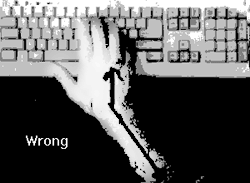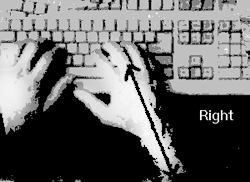Office Ergonomics
CUMULATIVE TRAUMA DISORDERS
INCLUDING CARPAL TUNNEL SYNDROME
To understand Cumulative Trauma Disorders (CTDs), it is necessary to understand how the body works. Body movements are produced by contracting and relaxing muscles. The muscles are attached to bones by tendons. Tendons are smooth, and in some parts of the body they glide back and forth inside tubes called synovial sheats. The sheat produces a lubricant called synovial fluid to help the tendons glide easily. CTDs result when repeated stress is placed on the tendons, muscles, or nerves causing inflammation or damage.
The following are some of the most common CTDs:
- Tendonitis - inflammation of the tendons
- Tenosynovitis - inflammation of the synovial sheat
- Carpal Tunnel Syndrome - results when the median nerve is compressed, either from the swelling of tendons and sheats or from repeated bending of the wrist
Some of the conditions that may lead to CTDs are:
- Repetition - long or concentrated hours of typing or using a mouse
- Posture - long hours of sitting in the same position while typing, especially if it is in an uncomfortable or poorly supported position, or if the wrists are bent
- Lack of Rest - intensive hours at the keyboard with few breaks
Symptoms of CTDs:
- Tingling or numbness in the hands or fingers
- Pain in fingers, hands, wrists, or even shooting up into the arms or forearms
- Loss of strength or coordination in the hands
- Numbness or discomfort in the hands which wakes you up at night
CARPAL TUNNEL SYNDROME
According to the Medical Multimedia Group, an excellent source of on-line medical information, Carpal Tunnel Syndrome is a common problem that affects the hand and wrist. This condition, or syndrome, has become the focus of much attention in the last few years due to suggestions that it may be linked to occupations that require repetitive use of the hands - such as typing.
For more detailed information on Carpal Tunnel Syndrome, including some great graphics, check out MMG's Carpal Tunnel site.
PREVENTING CTDS TO HANDS AND WRISTS
One of the keys to preventing CTDs is to keep your hands and wrists in as "neutral" a position as possible. In other words, you want to avoid typing with your wrist bent to either side, or up or down. You do not want your wrists to be flexed in any direction.


The neutral position may be obtained by adjusting your desk height, chair height, or keyboard position. Here are some tips for preventing hand and wrist CTDs:
- The keyboard should be slightly lower than normal desk height. If it is not low enough, try raising your chair height. Prevent your legs from dangling by using a footrest.
- "Home row" of keys should be at elbow level.
- While typing, it is best not to rest your wrists, and they should not be bent up, down, or to the side. This may be easier if the back edge of the keyboard is tilted down slightly, away from you. The knuckle, wrist, and top of forearm should form a straight line. Wrist supports or rests give you a place to rest your hands only when pausing from typing, not while you are typing.
- Do not pound the keys. Use a light touch.
- Use two hands to perform double key operations like Ctrl-C or Alt-F instead of twisting one hand to do it.
- The elbows should form a 90 degree angle while "hanging" at the sides from the shoulders. The shoulders should remain relaxed in a lowered position while typing.
- Take lots of breaks to stretch and relax. Take frequent "micro-breaks" (lasting a few seconds or so) as well as longer (several minute) breaks every hour or so.
- Hold the mouse lightly.
- Keep your hands and arms warm.
If you are routinely experiencing symptoms of CTDs in your hands, wrists or arms, you probably need to see a doctor. Pain or numbness is a good indication that damage is being done, and early treatment is essential to limit that damage. It is not recommended that you try to treat CTDs by yourself. In some cases, for example, wrist supports or splints may make matters worse. Always check with a qualified physician before using such a device.
GOOD LINKS TO HAND/WRIST ERGONOMIC INFORMATION
- Carpal Tunnel Syndrome: A Patient's Guide (Medical Multimedia Group)
- Typing Injury FAQ
- University of Nebraska-Lincoln RSI
- Carpal Tunnel Syndrome: Another Source of Self Care
PREVIOUS: ERGONOMICS | NEXT: EYE STRAIN
Introduction | Ergonomics | CTDs | Eyestrain | Workstations | Quiz
